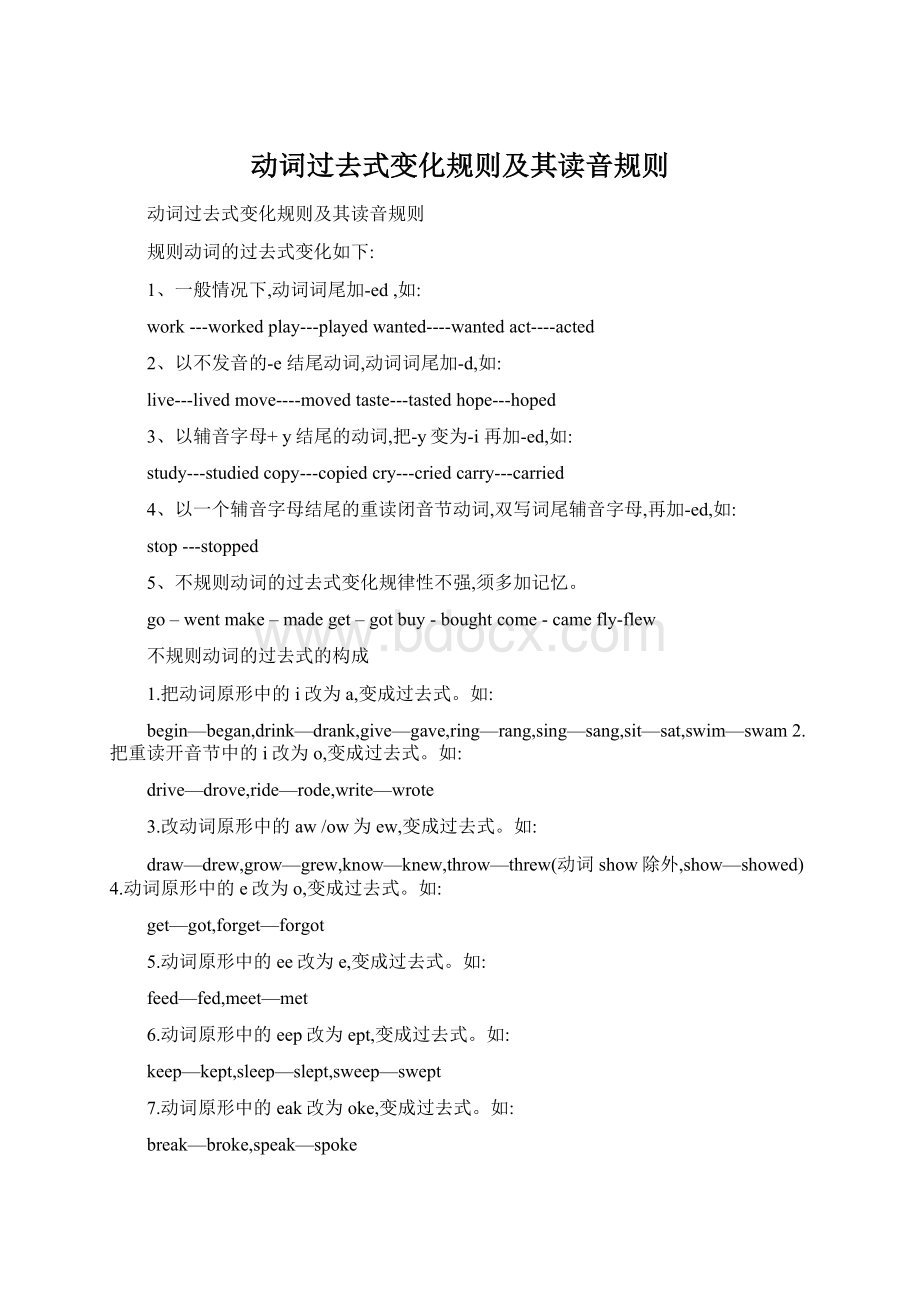动词过去式变化规则及其读音规则Word格式.docx
《动词过去式变化规则及其读音规则Word格式.docx》由会员分享,可在线阅读,更多相关《动词过去式变化规则及其读音规则Word格式.docx(8页珍藏版)》请在冰豆网上搜索。

6.动词原形中的eep改为ept,变成过去式。
keep—kept,sleep—slept,sweep—swept
7.动词原形中的eak改为oke,变成过去式。
break—broke,speak—spoke
8.动词原形中的ell改为old,变成过去式。
sell—sold,tell—told
9.动词原形中的an改为oo,变成过去式。
stand—stood,understand—understood
10.以ought和aught结尾,且读音是〔:
t〕的过去式。
bring—brought,buy—bought,think—thought,catch—caught,teach—taught
11.以ould结尾且读音为〔ud〕的情态动词过去式。
can—could,shall—should,will—would
12.把动词原形中的o改为a,变成过去式。
come—came,become—became
13.在动词原形后加d或t变成过去式,并且发生音变。
hear〔hi〕—heard〔h:
d〕,say〔sei〕—said〔sed〕,mean〔mi:
n〕—meant〔ment〕
14.动词的过去式与动词原形一样。
let—let,must—must,put—put,read—read〔red〕
15.不符合上述规律的动词过去式。
am,is—was,are—were,build—built,do—did,eat—ate,fall—fell,feel—felt,find—found,fly—flew,go—went,have/has—had,hold—held,leave—left,make—made,may—might,run—ran,see—saw,take—took
过去式―-ed‖的发音规则
(1)动词词尾为―t,d‖时,发/id/音,
want→wanted(要)need→needed(需要)
(2)动词词尾为清辅音时,发/t/音。
help→helped(帮助)laugh→laughed(笑)look→looked(看)
kiss→kissed(吻)wash→washed(洗)watch→watched(注视)
(3)动词词尾为t,d以外之浊辅音或元音时,发/d/音。
call→called(叫)stay→stayed(停留)cry→cried(哭)
摘要:
一.一般现在时行为动词词型变化形式一般现在时动词只有第三人称有词形变化,其他人称动词均用原形单数第三人称动词变化:
多数在动词后加splay-playslike-likes,以s,x,sh,ch,o结尾的动词加esgo-goeswas
一.一般现在时行为动词词型变化形式
一般现在时动词只有第三人称有词形变化,其他人称动词均用原形单数第三人称动词变化:
多数在动词后加splay-playslike-likes,
以s,x,sh,ch,o结尾的动词加esgo-goeswash--washes,
以辅音字母加y结尾,把y改i再加esfly-fliesstudy--studies
二.一般现在时动词be和have的变化形式
1.动词Be叫连系动词,连系动词be的用法:
除了第一人称单数用am,和第三人称单数用is以外,其它人称用are。
Iambusy.Youarebusy.He(She)isbusy.We(You,They)arebusy.
2.动词have的用法:
除了第三人称单数用has以外,其它人称一律用have。
Ihaveapen.Youhaveapen.She(He)hasapen.
We(You,They)havepens.
三.一般现在时的句型
1.肯定句构成:
主语+动词(注意人称变化)+其它成分
Ihaveadog.Welikethelittlecat.Shesingswell.
2.否定句构成:
行为动词的否定句:
主语+助动词(do/does)+not+动词原形+其它成分
Hedosen…thaveadog.Heisn?
tyoung.Wedon…tlikethelittlecat.
(借助于助动词do)Shedoesn?
tsingwell.(借助于助动词does)
3.一般疑问句:
A.行为动词的一般疑问句:
助动词(do/does)+主语+动词原形+其它成分
Doyoulikeit?
Yes,Ido./No.Idon…t.Doeshe(she)likeit?
Yes,he(she)does./No,he(she)doesn?
t.
B.动词BE的一般疑问句Am/Is/Are+主语+其它成分
Areyouateacher?
Yes,Iam./No,Iamnot.
Aretheystudentsofyourschool.Yestheyare/Notheyaren,t.
4.特殊疑问句:
特殊疑问词+一般疑问句
Howmanystudentsarethereinyourschool?
WhatdoyouusuallydoonSunday?
四.一般现在时的用法
1.经常性或习惯性的动作,常与表示频度的时间状语连用。
everyyear,sometimes,at5o…clock,onSunday.
Igetupatsixo?
clockeveryday.
Hegetsupatsixo…clockeveryday.
Shesmokestoomuch.
Itelephonetomyparentsonceaweek.
2.表达客观真理,科学事实。
如果出现在宾语从句中,即使主句是过去时,从句谓语也要用一般现在时。
Threeandfourmakesseven.
Theteachertoldusthattheearthmovesaroundthesun.
ShenyangliesinthenorthofChina.
3.在格言或名言警句中。
Pridegoesbeforeafall.骄必败。
Actionsspeaklouderthanwords.事实用于雄辩。
4.表示现在的状态、性格、个性。
Idon?
twantmore,thanks.
Heisagoodstudent.Heisalwaysreadytohelpothers.
五.一般现在时其它用法
一般现在时表将来
1.含有go,come,return,arrive,leave,start,begin等动词的一般现在时表将来。
表示在时间上已确定或安排好的事情。
Theschoolbusleavesateight.
2.在时间或条件句中。
WhenTomcomes,askhimhowtofixthetap.
I…llhelpyouassoonasIarrivethere.
3.在动词hope,takecarethat,makesurethat等后。
Ihopeshehasagoodtime.
Beforeyouleavetheroom,pleasemakesurethatthedoorisclosed.
4.时间状语从句,条件句中,从句中(常含有till,once,assoonas,
when,while,before,after,solongas,bythetime,if,incase,
unless,evenif,whether,themoment,theminute)
Eg.AssoonasIgetthere,Iwilldealwiththismatter.
Whetherheishappyisanimportantthingtoher.
5.倒装句,表示动作正在进行
Herecomestheteacher!
=Theteacheriscoming.
Theregoesthebell.=Thebellisringing.
Herecomesthecar.=Thecariscoming.
一般现在时表过去
1.“书上”,“报纸上”的叙述。
Thenewspapersaysthatthepresidentwillretirenextmonth.
2.叙述往事,使其生动。
Napoleon?
sarmynowadvancesandthegreatbattlebegins.
一般现在时表完成
1.动词用一般现在时代替完成时:
hear,tell,learn,write,understand,forget,know,find,say,remember.
Eg.Ihear(=haveheard)hewillgotoParis.
Iforget(=haveforgotten)howtoreadtheword.
2.句型“Itis...since...“=“Ithasbeen...since...”
Itis(=hasbeen)fiveyearssincewelastmet.
一般现在时表进行
1.句型:
Herecomes...;
Theregoes...
Eg:
Look,herecomesMr.Brown.
六.注意事项
1.在英国,人们常用havegot代替have,特别在疑问句和否定句中。
2.当have如果不表示“有”时,构成疑问或否定句时,就借助于助动词do,does,don…t或者doesn?
练习
一.用词的适当形式填空。
1.Whattime_________hisfather_________(do)thework?
2.He_________(get)upatfiveo…clock.
3.__________you_________(brush)yourteetheverymorning.
4.What________(do)heusually________(do)afterschool?
5.Tom________(study)English,Chinese,Maths,ScienceandArtatschool.
6.Kittysometimes__________(go)totheparkwithhissister.
7.Ateightatnight,she__________(watch)TVwithherparents.
8.________Mike________(read)Englisheveryday?
9.Howmanylessons________yourclassmates______(have)onMonday?
10.Weoften___________(play)footballintheplayground.
二.选择
()1._____youhaveabook?
A.Do
B.Are
C.Is
D.Have
()2.They_________onafarm.
A.working
B.iswork
C.work
D.isworked
()3.DoesPeterliketowatchTV?
__________.
A.Yes,helike
B.No,hedoesn?
t
C.Yes,he…dlike
D.No,helikes
()4.Shedoesn?
t__________herhomeworkintheafternoon.
A.doing
B.todo
C.does
D.do
()5.How____________Mr.Brown___________toAmerica?
A.do,go
B.is,go
C.does,go
D.does,goes
()6.Where…smycamera?
I____________it.
A.amnotfinding
B.amnotseeing
C.can?
tfind
D.can…tlookat
()7.How___________hegotowork?
He___________toworkbybike.
A.does;
go
B.do;
goes
C.do;
D.does;
()8.______youusuallylateforschool?
No,_____________.
A.Do;
Iam
B.Does;
not
C.Are;
I?
mnot
D.Are;
Iaren…t
()9._____she_____homeatsixeveryday?
A.Is,leave
B.Does,leave
C.Is,leaves
D.Does,left
()10.Mr.Yang____________Englishthisterm.
A.teachesour
B.teachesus
C.teachsus
D.teachour
答案:
一.1.does,do2.gets3.Do,brush4.does,do5.studies6.goes7.watches8.Does,read9.do,have10.play
二.1---5ACBDC6---10CDCBB